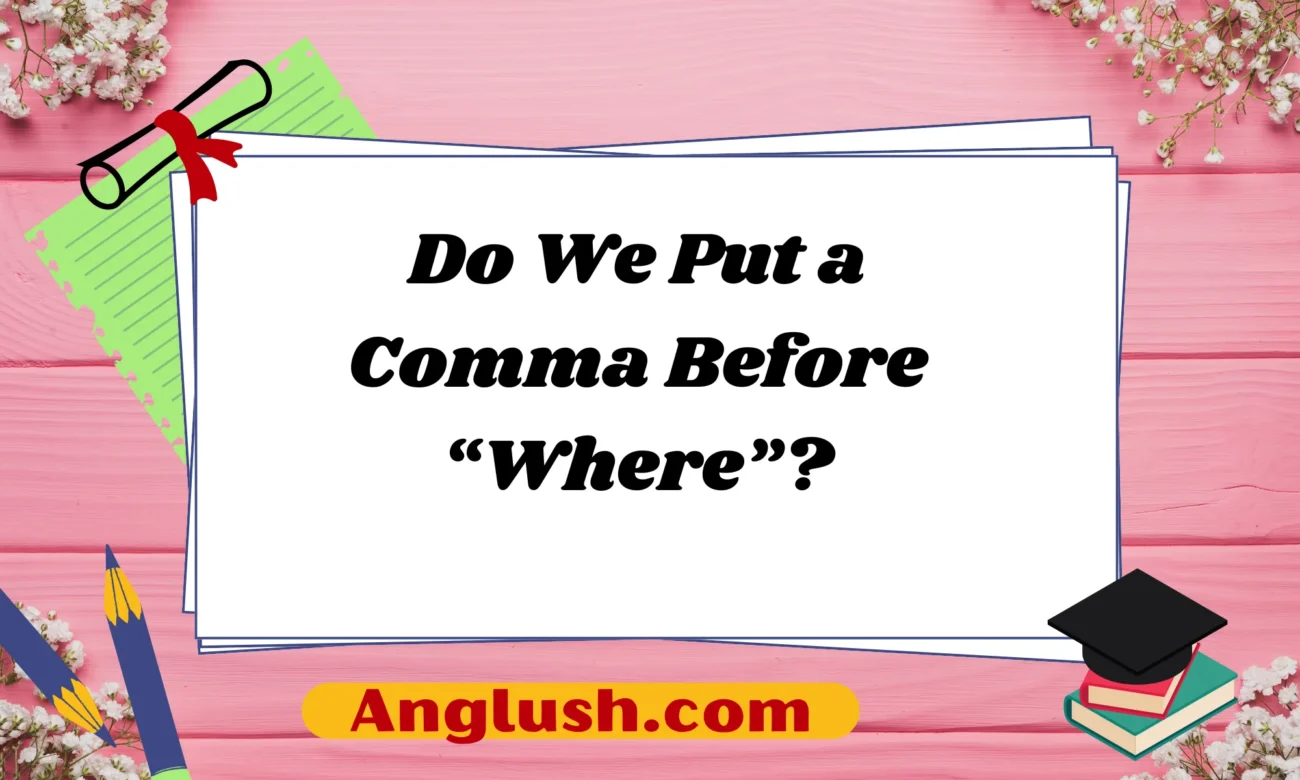Introduction
The English language is full of punctuation rules that can be tricky, and one common question that arises is: Do we put a comma before “where”? The answer depends on the structure of the sentence and the role that “where” plays.
In this article, we’ll explore when a comma is necessary before “where,” when it should be omitted, and how the meaning of a sentence can change based on punctuation. We will provide numerous examples, including both formal and informal writing situations, and offer guidance on best practices.
When Do You Use a Comma Before “Where”?
The decision to place a comma before “where” largely depends on whether the clause following “where” is restrictive or non-restrictive. Let’s break down these two cases:
1. Use a Comma Before “Where” in Non-Restrictive Clauses
A non-restrictive clause adds extra information that is not essential to the main meaning of the sentence. If you remove it, the sentence still makes sense.
🔹 Example:
- The café, where we first met, has closed.
In this case, “where we first met” provides additional (but non-essential) information. The sentence still makes sense without it:
- The café has closed.
Thus, we use a comma before “where” to indicate that this clause is extra information.
More Examples of Non-Restrictive Clauses:
- My grandmother’s house, where I spent most of my summers, is being renovated.
- The library, where I usually study, was unexpectedly closed today.
- We visited the museum, where the new exhibit was displayed.
2. Do Not Use a Comma Before “Where” in Restrictive Clauses
A restrictive clause provides essential information needed to understand the meaning of the sentence. Without it, the sentence would lose important context.
🔹 Example:
- The café where we first met has closed.
In this case, the phrase “where we first met” is necessary to specify which café we are talking about. Removing it would change the meaning of the sentence.
More Examples of Restrictive Clauses:
- The house where I was born is now a museum.
- The shop where she works is closing down next month.
- The school where he studied is known for its excellent faculty.
Quick Rule Summary
| Case | Comma Before “Where”? | Example |
| Non-Restrictive Clause (extra information) | ✅ Yes | The park, where we had our picnic, was very crowded. |
| Restrictive Clause (essential information) | ❌ No | The park where we had our picnic was very crowded. |
Other Cases Where a Comma Might Be Needed Before “Where”
While restrictive and non-restrictive clauses are the most common reasons for adding or omitting a comma before “where,” there are other cases to consider.
1. When “Where” Starts a Non-Essential Phrase in the Middle of a Sentence
🔹 Example:
- I love traveling, where possible, to experience new cultures.
Here, “where possible” is an extra phrase that adds information but is not essential to the sentence, so we use a comma.
2. When “Where” Is Used in an Introductory Clause
🔹 Example:
- Where necessary, adjustments will be made.
In this case, “where necessary” introduces the sentence, so a comma follows it.
3. When “Where” Is Used in Parenthetical Expressions
🔹 Example:
- You should apply the rule, where applicable, to all cases.
“Where applicable” is a parenthetical expression, so it is set off by commas.
11 Texting Examples Using “Where” Correctly
Here are some examples of how “where” is used in text messages, ensuring both clarity and correctness:
- Restrictive (No Comma):
- Let’s meet at the café where we first had coffee.
- Non-Restrictive (With Comma):
- We’re going to the lake, where we used to go fishing as kids.
- Short Informal Use:
- Do you remember the place where we had dinner last time?
- Casual Suggestion:
- I know a great park where we can have a picnic!
- Clarification:
- That’s the store where I found the best deals.
- Expressing a Memory:
- This is the beach, where we made so many memories.
- Providing Direction:
- Take the first left, where you see the gas station.
- Giving an Explanation:
- Here’s the street, where my grandparents used to live.
- Professional Message:
- The conference will be held at the Hilton Hotel, where we met last year.
- Making a Suggestion:
- Let’s go somewhere where we can talk in peace.
- Confirming a Location:
- Is this where we’re supposed to meet?
Common Mistakes to Avoid
1. Using a Comma Before “Where” in a Restrictive Clause
🚫 Incorrect: The school, where she studied, is highly rated.
✅ Correct: The school where she studied is highly rated.
2. Forgetting the Comma in a Non-Restrictive Clause
🚫 Incorrect: The restaurant where we had dinner, was very expensive.
✅ Correct: The restaurant, where we had dinner, was very expensive.
3. Using a Comma in an Essential Parenthetical Expression
🚫 Incorrect: We should go, where possible to the event.
✅ Correct: We should go, where possible, to the event.
Final Thoughts
Understanding when to use a comma before “where” is essential for clear and effective writing. The key takeaway is:
- If the clause following “where” is non-restrictive (adds extra information), use a comma.
- If the clause is restrictive (essential to the meaning), do not use a comma.
By following these rules, your writing will be grammatically correct and easier to read. Whether you’re writing a formal document, an email, or a casual text, applying these guidelines will help you communicate more clearly.

